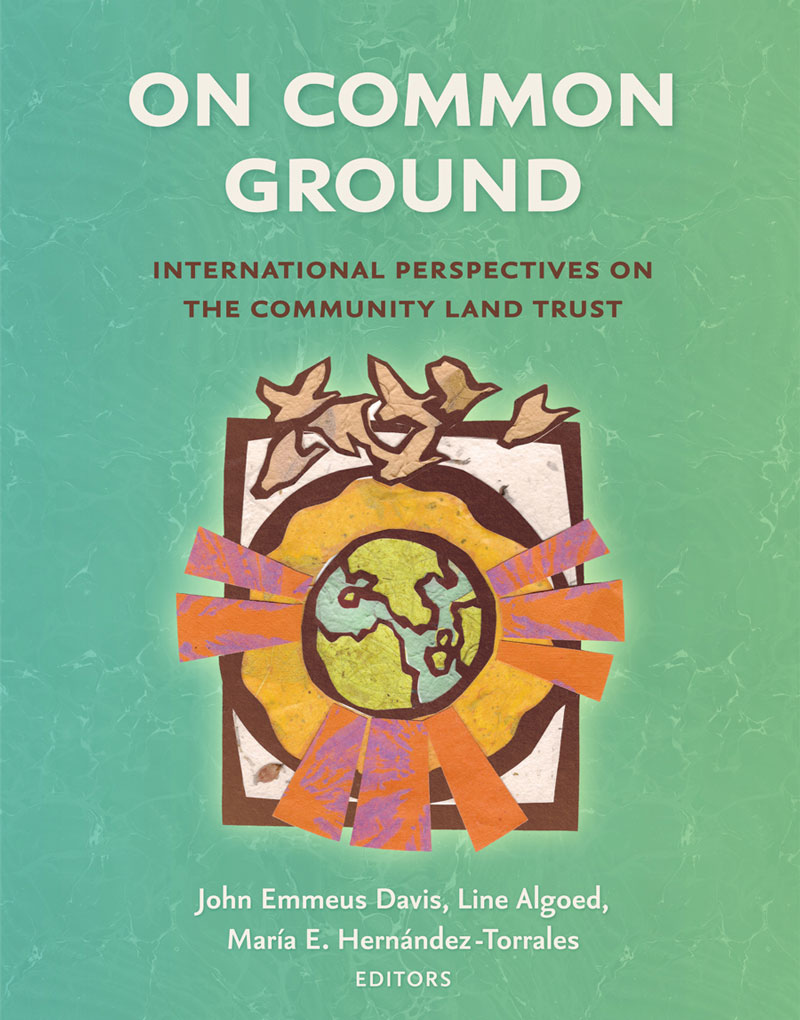
Excerpt: From John Emmeus Davis, “Common Ground: Community-Owned Land as a Platform for Equitable and Sustainable Development,” On Common Ground: International Perspectives on the Community Land Trust, eds. John Emmeus Davis, Line Algoed and María E. Hernández-Torrales. Madison, Wisconsin: Terra Nosta Press, June 2020, pp. 38-40. Additional information about the book’s twenty-six chapters, contributed by 42 authors from a dozen different countries, can be found at: www.cltweb.org.
Long ago, Andre Gorz, a social philosopher living in France, drew a distinction between ameliorative measures that buttress existing relations of property and power versus those that open tiny cracks in the structure of inequality, slowly accumulating over time to offer an ideological and political challenge to the status quo. He called the first “reformist reform” and the second “non-reformist reform.”[1]
Gorz’s categories were later revived and provocatively applied by James Meehan in his examination of community land trusts in the United States, using the Dudley Street Neighborhood Initiative in Boston as his principal case. He concluded:
It is clear that CLTs, in their diverse character and situations, walk the fine dividing line between the two tendencies of reformist and non-reformist. In many cases, the CLT legal model has been used as a gimmick to keep low-income housing costs low (thus taking pressure off the state and the private sector). In others, they play a role in raising consciousness to the realities of power in regard to land, questioning speculative ownership of land, and enabling some degree of community control over the local land base.[2]
Meehan captures well the tension between the pedestrian, day-to-day practice of CLTs and the loftier, transformative possibilities that may result from their work. CLTs are, in fact, an effective scheme for lowering housing costs, preserving affordability, promoting upkeep, and preventing foreclosures. This full-cycle commitment to cost reduction at the front end and dependable stewardship at the back end is a marked improvement over the build-and-bolt mentality embodied in most other programs for boosting low-income people into homeownership.
At the same time, a community land trust, like every other organization working to improve conditions and to expand opportunities for disadvantaged people, inadvertently reinforces the hold of dominant institutions. When CLTs expand access to mortgage capital for populations and places that have experienced redlining in the past, they contribute to the legitimization of a system of private finance that has been a source of woe for low-income communities, especially communities of color. When CLTs expand access to homeownership for people who have been excluded from the private market, they affirm the individualization of property that has been a flashpoint in the politics of place, where interests of property drive a contentious wedge between owners and renters, and between haves and have-nots. Community land trusts, from this perspective, can be seen as a reformist tool for propping up the status quo, softening the edges of a harmful system that is left unchallenged and unchanged.
There is another way of looking at it, however, for the cumulative effect of community-led development on community-owned land may be to transform that system into something else. An ideology of possessive individualism, used by landlords and homeowners alike to justify their capture of all gains in value accruing to real property, is challenged by a CLT’s dogged pursuit of a more equitable balance between the legitimate interests of individual residents and the legitimate interests of the community around them, secured through common ground.[3] The power of private lenders is moderated by the CLT’s front-end right to approve all mortgages for buildings sited on its land, screening against predatory lending; it is also blunted by the CLT’s back-end right to intervene in cases of mortgage default, preventing most foreclosures. The politics of place are modified by a nonprofit landowner that is drawn into sharing and wielding power on behalf of residents living on and around its land.
Admittedly this happens within the geographic confines of a rather limited territory, encompassing a service area as small as a single neighborhood for some CLTs. It also happens within the functional confines of a limited circle of institutions that determine how land-based wealth is distributed and how real estate is owned, regulated, and financed. Community-owned land may be a creative vehicle for non-reformist reform, but its territorial and institutional reach may not extend very far.[4]
It may be argued, on the other hand, that any institution that offers a counter-narrative to practices and meanings that buttress inequality carries a seed of possibility for influencing a wider circle of places, institutions, and policies. When one community prudently plans for success by improving conditions in a particular place without displacing its most vulnerable residents, it raises the question of why equitable development isn’t a priority of every neighborhood improvement plan. When community-led development on community-owned land creates a stock of housing that is permanently affordable in the face of market forces that pose a credible threat to all affordably priced housing, most of which would not exist without governmental funds or inclusionary mandates, it raises the question of why sustainable development is not a requisite of all housing policy.
A community land trust, from this perspective, represents what Ulrich Beck has called a “creative construction,” a social innovation that not only transforms relations within its particular sphere of influence but brings pressure to bear on the intellectual and political systems that surround it, “besieging what exists with a provocative alternative.”[5] In a similar vein, Erik Olin Wright has pointed to “community-controlled land trusts” as one of several strategies for achieving what he calls “interstitial transformations.” These are alternative institutions that “seek to build new forms of social empowerment in the niches and margins of capitalist society, often where they do not seem to pose any immediate threat to dominant classes and elites.”[6]
Sign up for our free newsletters
Subscribe to NPQ's newsletters to have our top stories delivered directly to your inbox.
By signing up, you agree to our privacy policy and terms of use, and to receive messages from NPQ and our partners.
It cannot be said that most people who are drawn to a CLT, whether as practitioners or beneficiaries, are motivated by the prospect of mounting some sort of ideological, institutional, or political challenge to the status quo. Most have little interest in “besieging” anything. They may be blissfully unaware of the transformative potential of community-owned land beyond its immediate utility in helping low-income people to obtain and retain a home. Even those who passionately embrace the CLT as a vehicle for moving toward a more just society may speak only in whispers about the radical proposition at the heart of the model they employ. As the sweet old lady confided to a colleague of mine several years ago, while talking proudly about the success of her own CLT in doing both urban agriculture and affordable housing on community-owned land, “What we are really about is land reform, but we hide behind the tomatoes.”
Such reticence is understandable. A community land trust must think twice about calling too much attention to unconventional (and sometimes controversial) elements in its make-up when its leaders must continually beg for grants from public funders, apply for loans from private lenders, and anticipate attacks from reactionary neighbors opposed to anything being built near their own backyards.
Stealth has a price, however. When an innovation like common ground is cautiously kept out of the limelight, it is simultaneously kept off the stage, waiting forever in the wings. To move from the periphery to the mainstream, CLTs must be prepared to strut their stuff and prove their worth, confidently proclaiming that their way of doing community development is preferable to the way it is normally done. Hiding behind the tomatoes may help a fledgling CLT to get established or may enable a beleaguered CLT to survive, but it does little to demonstrate the comparative advantage of common ground. It hides the fact that community-led development on community-owned land is not “just as good” as more conventional strategies of place-based development. It is better.
It is better because community land trusts are, at heart, more than simply another gimmick for lowering the cost of housing and cultivating a new crop of homeowners. What they are “really about” is equitably and sustainably replanting the contested ground at the intersection of property, power, and place. That may not be something to which all CLT practitioners aspire. That may not be something of which all CLT practitioners speak. But whenever land is controlled by a community within the participatory framework of a CLT, the transformative potential is present to nudge the places where people reside toward greater security and opportunity for all. Common ground provides a versatile platform for promoting development with justice—and justice that lasts.
[1]Andre Gorz, Strategy for Labor: A Radical Proposal (Boston MA: Beacon Press, 1964).
[2] James Meehan, “Reinventing Real Estate: The Community Land Trust as a Social Invention in Affordable Housing,” Journal of Applied Social Science 20 (2013, p. 113).
[3] From the earliest days of the CLT, its advocates have wrestled with the question of exactly what these “legitimate” interests might be. A seminal discussion of this issue can be found in Institute for Community Economics, The Community Land Trust Handbook (Emmaus PA: Rodale Press, 1982). Many other thinkers have wrestled with the same philosophical question. See: R.H. Tawney, The Acquisitive Society (New York: Harcourt, Brace and World, 1920); and Reinhold Niebuhr, The Children of Light and Darkness (New York: Charles Scribner and Sons, 1944).
[4] James DeFilippis, for one, has expressed doubts about CLTs producing society-wide change. While conceding that CLTs “provide a framework for ownership that is both equitable and viable,” he notes their lack of an oppositional politics and their limited institutional reach. James DeFilippis, Unmaking Goliath: Community Control in the Face of Global Capital (New York: Routledge, 2004). Quote at p. 148.
[5] Ulrich Beck, Individualization: Institutionalized Individualism and Its Social and Political Consequences (Mike Featherstone ed., 2005). Quote at pp. 190–191.
[6] Erik Olin Wright, Envisioning Real Utopias (London: Verso, 2010).









